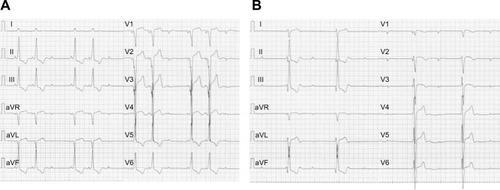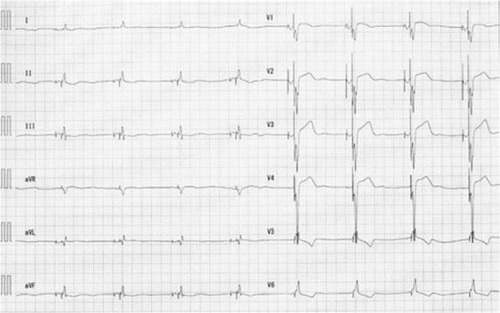Abstract
A 32-year-old man with Duchenne muscular dystrophy (DMD) was admitted to the hospital because of worsening dyspnea and general fatigue. He had received medication therapy for cardiomyopathy with heart failure and home mechanical ventilation for respiratory failure. An electrocardiogram on admission showed intermittent third-degree atrioventricular block. Echocardiography showed global mild left ventricular systolic dysfunction with dyssynchrony (ejection fraction: 45%). He underwent implantation of a cardiac resynchronization therapy–defibrillator. His B-type natriuretic peptide level was improved after cardiac resynchronization therapy–defibrillator implantation, and he remains asymptomatic. The incidence of cardiomyopathy increases with age. By adulthood, 100% of patients have cardiac involvement.
Introduction
Improvement of respiratory support and pharmacotherapy for heart failure has brought extension of life span to patients with Duchenne muscular dystrophy (DMD). However, the incidence of cardiomyopathy increases with age; 100% of patients have cardiac involvement by adulthood.Citation1 Some kinds of arrhythmia cause fatal matters as well as worsening heart failure. Some DMD patients will need device therapy such as a permanent pacemakerCitation2,Citation3 or an implantable cardioverter-defibrillator (ICD).Citation4 ICD and cardiac resynchronization therapy have not been established in DMD patients. However, it has been reported that these therapies are beneficial to cardiomyopathy patients with systolic dysfunction.Citation5,Citation6
Case report
A 32-year-old man with DMD was admitted to the hospital because of worsening dyspnea and general fatigue. The diagnosis of DMD was made by muscle biopsy when he was 5 years old. He had received ventilation support for respiratory failure by a volume-controlled ventilator from 20 years of age. Complete left bundle branch block (CLBBB) appeared in electrocardiogram from 3 years before this admission. At the same time, echocardiography revealed abnormal left ventricular wall motion and dyssynchrony. So, a small dose of carvedilol was started for cardiomyopathy. It was gradually increased to 10 mg/day. But he felt dizziness sometimes from 1 month before this admission. Electrocardiogram showed bradycardia with Mobitz type II second-degree atrioventricular block (). He was admitted for treatment of arrhythmia. On admission, his blood pressure was 90/50 mmHg, heart rate was 30 bpm, and oxygen saturation was 97% with room air. Electrocardiogram showed intermittent third-degree atrioventricular block (). Echocardiography showed global mild left ventricular systolic dysfunction with dyssynchrony (ejection fraction: 45%). No congenital heart disease or coronary stenosis was observed on cardiac computed tomography imaging. The results of laboratory tests showed elevation of plasma levels of creatine phosphokinase (843 U/L), troponin T (0.073 ng/mL), and B-type natriuretic peptide (BNP) (871.0 pg/mL). He underwent implantation of a cardiac resynchronization therapy–defibrillator (CRT-D) under general anesthesia because of strong systemic contracture. The device generator was implanted under the greater pectoral muscle with the assistance of a plastic surgeon because his subcutaneous tissue had very poor growth. Biventricular pacing was begun immediately after implantation of the CRT-D (). He was discharged home without any complications. Carvedilol was gradually increased to 20 mg/day. His ventilation support was continued with the same conditions as those before CRT-D implantation. His BNP level (196.0 pg/mL) was improved 7 months after CRT-D implantation. Furthermore, his BNP level was decreased to 116.0 pg/mL after 20 months, and he remains asymptomatic. He is free from complaint and hospitalization for worsening heart failure after CRT-D implantation.
Figure 1 Electrocardiograms before and after admission.

Discussion
DMD is an X-linked recessive disease that has an incidence of approximately one in 3,500 male births.Citation1 This disease results from mutations in the dystrophin gene on chromosome Xp21. Consequently, the absence of dystrophin results in the development of skeletal muscle weakness, cardiomyopathy, and respiratory muscle weakness. The incidence of cardiomyopathy increases with age. Approximately 25% of DMD patients have cardiomyopathy by 6 years of age, and 59% are affected between 6 and 10 years of age. By adulthood, 100% of patients have cardiac involvement.Citation1 Cardiomyopathy is due to replacement of myocardium by connective tissue or fat, and there is both cardiac dysfunction and arrhythmia. Progression of cardiomyopathy leads to heart failure and sudden death.
It has been reported that biventricular pacing is superior to conventional right ventricular pacing in patients with atrioventricular block and left ventricular systolic dysfunction.Citation5 Our patient had CLBBB with left ventricular dyssynchrony. His cardiac function was gradually getting worse for the last 3 years. Furthermore, cardiac function was expected to deteriorate after that. Moreover, the ventricular pacing was indispensable for atrioventricular block. Only right ventricular pacing might induce left ventricular dyssynchrony and deteriorate heart failure. Therefore, cardiac resynchronization therapy was suitable for the treatment of our patient, while CRT-D decreases the risk of heart failure events compared with an ICD alone in patients with a low ejection fraction and wide QRS complex.Citation6 However, the benefit of an ICD has not been established in DMD patients. But we could not deny the fatal ventricular arrhythmia, because this disease was a progressive disease. In addition, we thought that the reoperation for upgrade of pacemaker would not be easy for him because of his severe skeletal anomaly such as scoliosis and the risk of general anesthesia. Therefore, CRT-D was thought to be preferable for our patient as a primary prevention strategy.
Cardiac involvement occurs in some types of myopathies. Myotonic dystrophy types 1 and 2, Emery–Dreifuss muscular dystrophy, and limb–girdle muscular dystrophy (LGMD) type 1B are generally associated with conduction disease.Citation4 These types of muscular dystrophy need to be frequently implanted with a pacemaker. It is reported that an ICD is recommended in patients with Emery–Dreifuss muscular dystrophy and LGMD type 1B because of the risk of bradycardia and ventricular arrhythmia,Citation7 while DMD, Becker muscular dystrophy, and LGMD types 2C–2F and 2I are generally associated with a dilated cardiomyopathy.Citation4 Progression of cardiac dysfunction increases the frequency of sudden death. Fatal ventricular arrhythmia probably relates with sudden death. CRT-D has a good possibility of the prevention of progressive heart failure and sudden death. Although device therapy must be chosen according to individual conditions, CRT-D may become one of the therapies for arrhythmia and heart failure in patients with myopathy. Ehime University institutional review board has approved this study. Written informed consent was obtained from the patient.
Disclosure
The authors report no conflicts of interest in this work.
References
- RomfhAMcNallyEMCardiac assessment in Duchenne and Becker muscular dystrophiesCurr Heart Fail Rep20107421221820857240
- FayssoilAOrlikowskiDNardiOAnnaneDComplete atrioventricular block in Duchenne muscular dystrophyEuropace200810111351135218815187
- FayssoilAOrlikowskiDNardiOAnnaneDPacemaker implantation for sinus node dysfunction in a young patient with Duchenne muscular dystrophyCongest Heart Fail201016312712820557333
- GrohWJArrhythmias in the muscular dystrophiesHeart Rhythm20129111890189522760083
- CurtisABWorleySJAdamsonPBBiventricular versus Right Ventricular Pacing in Heart Failure Patients with Atrioventricular Block (BLOCK HF) Trial InvestigatorsBiventricular pacing for atrioventricular block and systolic dysfunctionN Engl J Med2013368171585159323614585
- MossAJHallWJCannomDSMADIT-CRT Trial InvestigatorsCardiac-resynchronization therapy for the prevention of heart-failure eventsN Engl J Med2009361141329133819723701
- MeuneCVan BerloJHAnselmeFBonneGPintoYMDubocDPrimary prevention of sudden death in patients with lamin A/C gene mutationsN Engl J Med2006354220921016407522

